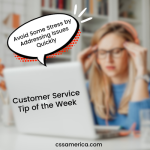
If there’s one thing I’ve heard repeatedly throughout the years it’s that MANY customer service people hate to sell. I’ve also heard that great salesmen are great at “servicing” their accounts. Now as “customer service people,” we can all agree that sales people who have a service-focus should perform better. We’re wired to serve, so naturally we’d feel that sales people would benefit from some similar wiring.
But customer service people don’t like to sell. We say: “It’s pushy. It’s product-driven, not people-focused. It’s uncomfortable. It’s me-focused instead of you-focused.”
In many ways those thoughts are correct, but we have to get over those stereotypes about selling and sales people. For customer service people to be the best we can be, we have to learn how to sell.
Think of selling using a different word – persuasion. We are often giving customers options to consider. They can renew their account today or next month. They could take medicine A or medicine B. They could pay online or in-person. They could return an item or get it repaired. They could return this semester or drop out of college.
Often – as service-focused individuals – we want to offer options and provide the facts for their decision, and then we stop.
But in our gut, if we truly care about that customer with us, we often know there’s a better option. We know that customers similar to them preferred a particular alternative. We know that – based on their unique personality, their specific issues, or their personal goals – one way is better than the other.
It’s their decision, but if we really want to provide great customer service, we need to use our skills to persuade them toward what decision may be best for them.
“While there are different times when you could renew, based on your preference for that location, I recommend you renew today to lock in those seats.”
“When we’ve had patients in your situation, they preferred medicine A because there are minimal side effects.”
“When people haven’t dined with us before, we often recommend this dish – it’s our specialty and really gives you a sense of what makes this experience special.”
When you’re serving, don’t be adverse to selling – particularly if selling is simply persuading the customer to make the best decision for them.
When offering options, don’t just state the facts – sell them.
Signup for FREE Tips! Contact Us More Resources for You Visit Our Home Page























